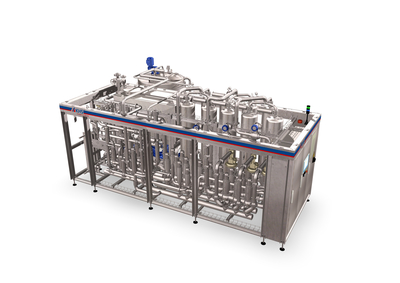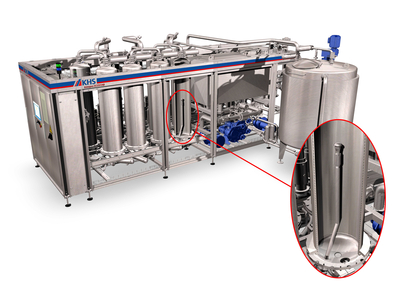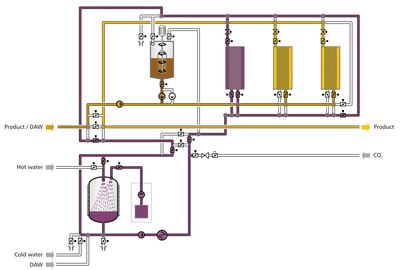
New Standards in Beer Stabilization
Innopro ECOStab offers one advantage after another
Ulrich Sander* Dr. Hans Westner** Beer stabilization is an indispensable step in achieving the longest possible shelf life for beer. Breweries usually rely on stabilization on the tannin side and the associated use of the stabilization medium PVPP (polyvinylpolypyrrolidone). The choice here is between lost and regenerative beer stabilization. The standard practice to date for regenerative beer stabilization has been to use a conventional gap candle filter or horizontal mesh filter system. As a rule of thumb, this investment is usually worthwhile beginning with beer outputs of around 400,000 hectoliters per year. With the newly developed Innopro ECOStab, KHS has made this rule of thumb obsolete. The Innopro ECOStab is a system that has been specially developed for regenerative beer stabilization and is worth using for significantly smaller beer quantities. Consequently, it is of just as much interest to small and medium-sized breweries as to large breweries. Among other things, this is because the investment costs are lower compared with conventional gap candle or horizontal mesh filter systems and a reduced volume of PVPP is required. The comparatively minimal operating costs thanks to reduced media consumption are a further plus point. Other important factors are that the Innopro ECOStab operates continuously with a high degree of automation, has a compact frame design enabling fast installation and commissioning of the modular system and permits the use of PVPP materials from different manufacturers. Low container volumes in the Innopro ECOStab also mean that the setup times for system startup and shutdown are short, that changeover times between various types of beer are kept brief, and that product losses are low. Tannin or albumen-side stabilization Tannins and proteins are jointly responsible for the formation of hazing in beer. This is because tannin and protein molecules come together over a period of time due to the influx of energy in the form of movement, heat, or light, and in doing so form agglomerates which are visible as cloudiness in the beer. * Process Engineering/Filter Manager, Process Engineering Competence Center, KHS GmbH, Tel.: +49 (671) 852-2283 **Manager, Project Handling, Process Engineering Competence Center, KHS GmbH, Tel.: +49 (671) 852-2329 This natural reaction can be delayed by stabilizing the beer, which means reducing one of the two reaction partners in the beer. Which of the two reaction partners this should be depends on widely differing parameters such as the quality of the raw materials, the cost of stabilization media, the beer manufacturing technology and the desired minimum shelf life. Finally, it is and remains also a question of philosophy. For the most part, breweries today rely on tannin-side stabilization using PVPP. One reason for this is that, in contrast to turbidity-related proteins, turbidity-related tannins are present in the beer in a ratio of approximately 1:40, and the objective of beer stabilization can consequently be achieved more effectively with tannin-side treatment. Another reason is that beer always contains a large number of widely differing proteins, some of which have a major effect on foam durability, richness of flavor and mouthfeel, and numerous breweries baulk at the risk of interfering with the protein system. Another aspect, which breweries often consider to be an argument against albumen-side beer stabilization, is that it is only a "one-way process". Here, silica gel is used as a reaction partner for the proteins together with the diatomaceous earth in a candle or horizontal mesh filter which, as well as stabilization, also carries out filtration tasks and is subsequently disposed of when the filtration and stabilization process is complete. The "one-way process" for tannin-side beer stabilization works in a similar way where non-reusable PVPP is dosed into the beer to be filtered and discarded together with the diatomaceous earth after filtration. Regenerative beer stabilization using PVPP If breweries decide in favor of recycling and for the related regenerative stabilization of beer using PVPP, it is necessary to invest in a separate beer stabilization system. The standard practice to date has been regenerative beer stabilization using a horizontal mesh (Innopro Cosmos) or gap candle filter (Innopro Getra Eco), slightly modified for the task of beer stabilization and connected directly downstream of the classical filtration process. The process can be briefly described as follows: reusable PVPP is fed into the filtered beer directly after clarifying filtration, it removes tannins from the beer and is then removed from the beer by the beer stabilizing system. When a stabilizing cycle is complete and consequently all the PVPP has been added and the maximum pressure volume in the filter achieved, the beer is forced out of the system with deaerated water. This is followed by the regeneration process for cross-linked PVPP. Reusable PVPP is purged with a 1% hot caustic solution; in doing so, enriched polyphenols are released to the caustic and thereby removed from the system. The regenerated and neutralized reusable PVPP passes to a purpose-built dosage tank for reuse.Three disadvantages of existing solutions lead to the innovative Innopro ECOStab There were three main aspects, which prompted KHS to develop a new system designed for beer stabilization in the form of the Innopro ECOStab. The first important point was that investment in a horizontal mesh or gap candle filter is associated with high costs, which are not acceptable for a relatively simple application. This high cost of investment can only be amortized for breweries with a beer output of less than 400,000 hectoliters in special cases. Investment costs for the Innopro ECOStab are clearly reduced in comparison. When using this new system, regenerative beer stabilization is justified for small and medium-sized breweries, which also benefit from more sustainable production by using the principle of regenerative beer stabilization. Another important aspect was that there are often problems, particularly when cleaning the horizontal mesh and gap candle filters designed for PVPP stabilization. The reason for this is that PVPP sticks to the filter elements and often cannot be removed using conventional cleaning methods such as backwashing. Blocked surfaces prevent a uniform precoating with PVPP. If this is not noticed and manual cleaning is not carried out, some parts of the system soon become overloaded, which can damage the filter elements. In order to prevent this risk occurring in the first place, the Innopro ECOStab has a clearly visible cleaning area. As the stabilization process in the Innopro ECOStab proceeds from the inside to the outside and PVPP is therefore restricted exclusively to the inner part of the filter elements, extremely reliable and complete cleaning of the entire surface can be carried out at high pressure using a centrally located jet cleaner. Manual cleaning is no longer necessary here. This ensures high system availability. A third disadvantage of existing systems remedied by the Innopro ECOStab is the work associated with batch operation when using classical PVPP precoat filters. The Innopro ECOStab uses several redundant system parts. When one stabilizer module is in the regeneration phase, the other begins production. This enables around-the-clock, 24/7 operation without stopping and - an aspect which is particularly important when connected to a crossflow filtration system - the output is continuous. Further positive aspects add to the range of advantages In addition to the three main aspects mentioned above, which were the inspiration for the Innopro ECOStab, the newly developed system also offers many further positives. While the classical beer stabilization cycle runs 10 to 20 hours, the stabilization cycle of the Innopro ECOStab takes 2 to 3 hours to complete. PVPP material is therefore regenerated much sooner with the Innopro ECOStab. This means that the utilization of PVPP here is disproportionately higher, as PVPP is not tied up unproductively in the process for several hours. PVPP usage is reduced by more than 50% compared with conventional systems thanks to the short production cycles of the stabilizer modules in the Innopro ECOStab and also because of the particularly low system container volumes compared with the conventional systems. This in turn results in significantly reduced PVPP material costs. The low container volumes chosen for the Innopro ECOStab also bring about additional advantages: shorter setup times for system startup and shutdown, minimized changeover times between various types of beer, and reduced blending amounts when changing beer types. Moreover, any PVPP material available on the market can be used in the Innopro ECOStab and there are no ties to specific manufacturers. Modular design and three capacity ratings Three versions of the Innopro ECOStab are currently available. A choice can be made between a stabilization capacity of 200, 400, or 600 hectoliters per hour. One of the characteristics of the system is its modular design. For the 200-hectoliter capacity stage, there are three stabilizer modules available, each of which has one column. The 400-hectoliter capacity version has three stabilizer modules, each with two columns, and the 600-hectoliter capacity version has three stabilizer modules, each with three columns. A filter cylinder is integrated into each column. In addition to the modules mentioned, each Innopro ECOStab system includes a PVPP dosing vessel and the regeneration unit. Constant stabilization with particularly intensive system utilization Two stabilizer modules are always in operation during the stabilization process. The third stabilizer module is provided as a standby module. The system consequently starts up with two modules. When the first module is half full with PVPP, the system switches over to the third module so that the first can be regenerated. When the regeneration of the first module is complete, it is put back into operation and the second module starts to regenerate. This effectively continuous method of operation ensures that beer can be drawn from the upstream system at any time. Similar to conventional PVPP filters, the amount of PVPP dosed is proportional to the flow of beer. This ensures that the beer is always stabilized with the quantity of PVPP, which is intended by the brewery's quality assurance department. Over-stabilization and under-stabilization are ruled out. Maximum production and product safety A significant number of the instruments used in the Innopro ECOStab are provided with redundancy in mind for maximum production and product safety. Moreover, in order to meet maximum hygiene requirements, the Innopro ECOStab is equipped only with state-of-the-art components such as leakproof double-seat valves with individually controllable valve seats. Quick adjustment to new conditions The actual process of beer stabilization in the Innopro ECOStab is carried out as follows: filtered beer is pump to the system by a product pump. The PVPP dosing vessel dispenses PVPP into the product line by means of a redundant dosing pump. The beer mixed with PVPP then passes into one of the two stabilizer modules in use where the actual stabilizing process takes place. The Innopro ECOStab has a turbidity meter integrated into the product line. This ensures that exactly the quantity of PVPP required by the product is added at all times. Within the stabilizer modules, the beer mixed with PVPP is fed through the filter cylinders in the columns. While the beer passes through the filter cylinders, regenerative PVPP remains on the filter surface and forms a uniform precoating layer. The beer stabilization process can be followed by carbonation and regulation of the original gravity or by particle filtration, for example. Regeneration process thought out down to the last detail Optimized container volumes and process technology enable the regeneration process to be reduced to about 45 minutes with reproducible results. Reduced media consumption and minimized wastewater amounts are positive side effects to the time saved. At the end of each regeneration period, when the PVPP has been discharged into the batch tank, the filter surfaces are thoroughly cleaned by means of turbine-driven jet cleaners. In this way, the ongoing integrity of the metal filter surfaces is ensured within the shortest possible time at water pressures of up to 10 bar. Rinse water is collected in the CIP batch tank for reuse as a caustic solution for the next regeneration process. The water savings achieved in this manner are considerable compared with conventional systems. This specifically addresses the aspect of sustainability. Container dimensions promote rapid commissioning A further important advantage of the Innopro ECOStab is that the compact, modular machine is mounted on a frame and fits into one shipping container, making it easy to transport as a single unit. On delivery to the brewery, all that is required is to connect the pipes and incorporate the tank into the process. Compared with conventional systems, this considerably reduces the time needed for machine commissioning – in full keeping with the Plug & Produce principle. Economic stabilization and much more All told, the Innopro ECOStab is an extremely space-saving system that provides stabilization adapted exactly to the specific beer characteristics and in many respects points to the future in the brewing industry. Whether the use of small stabilizer modules, which compared with previous modules are responsible for lower product losses, shorter set-up times and minimal changeover times as well as lower PVPP volumes, reduced investment and operating costs, redundant system operation, flow-dependent PVPP dosage, increased product safety, etc. - in practice the Innopro ECOStab offers one advantage after another. Advantages the name of the innovative system already suggests: ECOStab stands for economic stabilizing.



